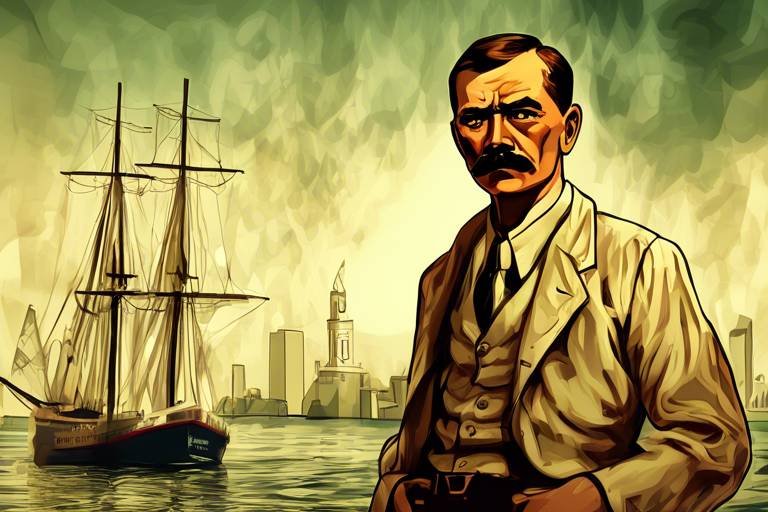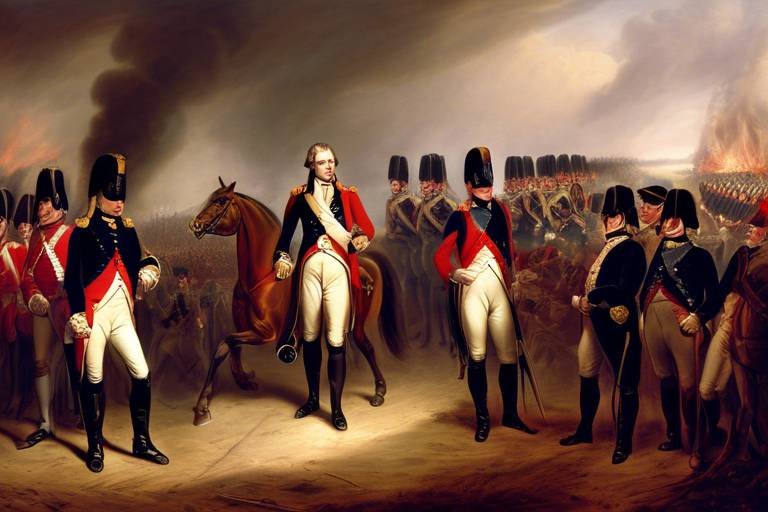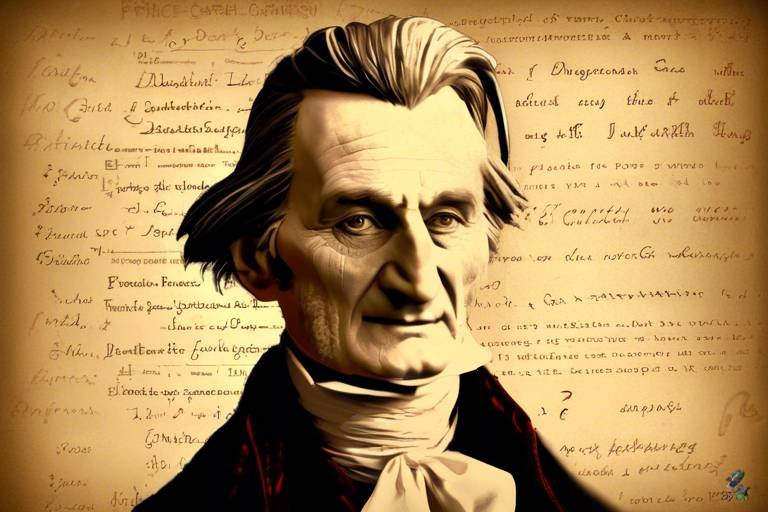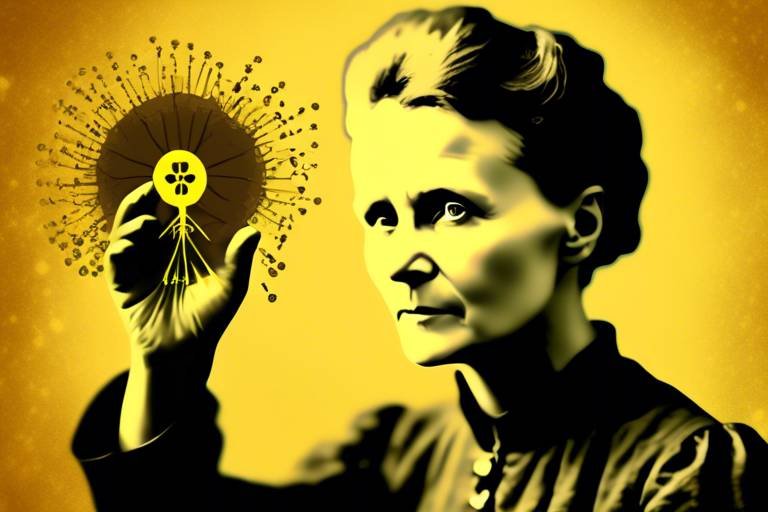Röntgen: The Discoverer of X-Rays
Wilhelm Conrad Röntgen, a name synonymous with innovation and scientific breakthroughs, forever changed the landscape of medicine and technology with his groundbreaking discovery of X-rays. Born in 1845 in Germany, Röntgen's journey towards this monumental revelation was filled with curiosity, perseverance, and a relentless pursuit of knowledge.
As a young man, Röntgen displayed a keen interest in the sciences, leading him to pursue a career in physics. His educational path was marked by academic excellence and a thirst for experimentation, laying the foundation for his future contributions to the scientific community.
It was during a series of experiments in 1895 that Röntgen stumbled upon something extraordinary - the existence of X-rays. In a moment of serendipity, he observed that these mysterious rays had the ability to penetrate solid objects and capture images of the internal structures without the need for incisions or invasive procedures.
Röntgen's discovery sent shockwaves through the scientific world, sparking a wave of excitement and intrigue. The implications of this breakthrough were profound, opening up new possibilities in the fields of medicine, imaging technology, and beyond.
The experimental setup Röntgen employed was simple yet revolutionary. Using a cathode ray tube and other basic equipment, he was able to produce X-rays and capture images that had never been seen before. This innovative approach paved the way for a new era in medical diagnostics and scientific exploration.
The significance of Röntgen's discovery cannot be overstated. Almost overnight, X-rays became a vital tool in the medical field, allowing doctors to diagnose conditions, detect fractures, and save countless lives. The long-term impact of this breakthrough continues to shape modern healthcare practices and technological advancements.
Röntgen's remarkable achievement did not go unnoticed. In 1901, he was awarded the Nobel Prize in Physics for his discovery of X-rays, solidifying his place in history as a pioneer in the field of science. This prestigious recognition served as a testament to the profound impact of his work.
Furthermore, Röntgen's discovery laid the groundwork for a wave of technological advancements in medical imaging. From CT scans to MRI machines, the legacy of X-rays lives on in the innovative tools and techniques used in modern healthcare settings.
Even today, Röntgen's discovery continues to shape the landscape of science and technology. The potential for future developments in the field of imaging and diagnostics is limitless, thanks to the pioneering work of this visionary scientist.

Early Life and Education
Wilhelm Conrad Röntgen, the pioneering scientist behind the discovery of X-rays, had a fascinating early life and educational journey that laid the foundation for his groundbreaking work. Born on March 27, 1845, in Lennep, Prussia (now Germany), Röntgen showed an early interest in the sciences. His educational path was marked by a strong focus on physics and mathematics, setting the stage for his future contributions to the field of science.
After completing his primary education, Röntgen pursued a degree in mechanical engineering at the Polytechnic in Zurich. However, his true passion for physics led him to switch his focus, eventually earning a Ph.D. in physics from the University of Zurich in 1869. This educational background equipped Röntgen with the knowledge and skills necessary to embark on a remarkable scientific journey that would change the course of history.

Discovery of X-Rays
Wilhelm Conrad Röntgen's discovery of X-rays marked a pivotal moment in the history of science and medicine. In the late 19th century, while conducting experiments with cathode rays, Röntgen stumbled upon a phenomenon that would change the world forever. His curiosity and dedication to scientific inquiry led him to uncover a form of electromagnetic radiation that could penetrate solid objects and capture images of the human body without the need for invasive procedures.
Imagine the astonishment and wonder that must have filled Röntgen's mind as he observed the invisible rays passing through objects, revealing their inner structures in a way never seen before. It was as if he had unlocked a hidden realm, a world of mysteries waiting to be explored. This accidental discovery not only showcased Röntgen's ingenuity but also laid the foundation for a new era in medical diagnostics and imaging technology.
Röntgen's experimental setup was simple yet revolutionary. Using a cathode ray tube and a fluorescent screen, he observed the strange glow produced by the rays passing through solid objects. This setup, coupled with meticulous observations and precise measurements, allowed Röntgen to document his findings and present them to the scientific community with confidence.
The significance of Röntgen's discovery cannot be overstated. Overnight, X-rays became a powerful tool in the hands of physicians, enabling them to diagnose fractures, locate foreign objects in the body, and detect various medical conditions with unprecedented accuracy. The impact of this technology reverberated across the globe, transforming the practice of medicine and saving countless lives in the process.
As news of Röntgen's discovery spread, the scientific community hailed him as a pioneer and visionary. His work earned him the prestigious Nobel Prize in Physics in 1901, solidifying his place in history as the father of radiology. The legacy of Röntgen's discovery lives on in the countless technological advancements that have stemmed from his initial breakthrough, shaping the landscape of modern healthcare and scientific research.
From the development of advanced imaging techniques to the integration of X-ray technology in various industries, Röntgen's legacy continues to inspire innovation and progress. The ongoing impact of his discovery serves as a testament to the enduring power of scientific curiosity and the boundless potential of human ingenuity.

Experimental Setup
When it comes to Wilhelm Conrad Röntgen's experimental setup that led to the groundbreaking discovery of X-rays, it's essential to understand the meticulous process and the innovative approach he undertook in his laboratory. Röntgen's experiments were a blend of scientific curiosity and methodical precision, setting the stage for a monumental breakthrough in the field of physics and medical imaging.
One of the key elements of Röntgen's experimental setup was the use of a cathode ray tube, a crucial component in his investigations. By passing high voltage electricity through the tube containing a low-pressure gas, Röntgen observed the emission of mysterious rays that could penetrate solid objects. This observation sparked his curiosity and set the wheels in motion for further exploration.
Röntgen's methodical approach involved meticulously shielding the experimental setup to isolate and study the properties of these mysterious rays. Using various materials such as cardboard, lead, and black paper, he systematically tested the penetrative abilities of the rays, leading to the discovery of their unique characteristics.
Furthermore, Röntgen's use of a photographic plate as a detector played a pivotal role in capturing the elusive nature of these rays. By placing objects between the source of the rays and the photographic plate, he was able to produce images that revealed the hidden structures within solid objects, a phenomenon that would revolutionize the field of medical imaging.
The experimental setup employed by Wilhelm Conrad Röntgen was not only innovative but also meticulously designed to unravel the mysteries of these newfound rays. Through his meticulous experiments and keen observations, Röntgen laid the foundation for a revolutionary discovery that would transform the world of science and medicine forever.

Significance of the Discovery
Wilhelm Conrad Röntgen's discovery of X-rays had a profound significance that reverberated across various fields of science and medicine. The revelation of this invisible form of electromagnetic radiation opened up new avenues for exploration and innovation, fundamentally transforming the way we perceive the human body and the world around us.
The significance of Röntgen's discovery can be best understood through its immediate impact on medical diagnostics. X-rays provided a revolutionary tool for physicians to visualize the internal structures of the body without invasive procedures, leading to more accurate diagnoses and targeted treatments. This breakthrough not only enhanced the efficiency of medical practices but also significantly improved patient outcomes.
Moreover, the discovery of X-rays ignited a wave of scientific curiosity and experimentation, prompting researchers to delve deeper into the properties of electromagnetic radiation. This newfound understanding laid the groundwork for advancements in various scientific disciplines, from physics to chemistry, unlocking a treasure trove of knowledge and possibilities.
Röntgen's discovery also had far-reaching implications beyond the realm of medicine. The ability to capture images of the invisible opened up new horizons in fields such as materials science, archaeology, and security. X-ray technology became instrumental in studying the composition of materials, uncovering hidden artifacts, and enhancing security measures through non-invasive inspections.
Furthermore, the discovery of X-rays exemplified the power of serendipity in scientific breakthroughs, underscoring the importance of curiosity, perseverance, and open-mindedness in the pursuit of knowledge. Röntgen's accidental discovery forever altered the course of scientific history, leaving an indelible mark on the collective imagination of humanity.

Recognition and Legacy
Wilhelm Conrad Röntgen's discovery of X-rays sent shockwaves through the scientific community, earning him immense recognition and leaving behind a lasting legacy that continues to shape modern technology and medicine. His groundbreaking work not only earned him the prestigious Nobel Prize in Physics but also set the stage for a new era of innovation in imaging technology.
When Röntgen's discovery was first revealed to the world in 1895, it was met with astonishment and excitement. The ability to capture images of the internal structures of the human body without invasive procedures was nothing short of revolutionary. Röntgen's name became synonymous with scientific excellence and ingenuity, solidifying his place in history as one of the most influential figures in the field of physics.
Receiving the Nobel Prize in Physics in 1901 further cemented Röntgen's legacy as a trailblazer in the world of science. The award recognized not only the significance of his discovery of X-rays but also the profound impact it had on the advancement of medical diagnostics and imaging technology.
Moreover, Röntgen's work laid the foundation for a wave of technological advancements that continue to shape our world today. The development of X-ray machines, CT scans, and other imaging technologies can all be traced back to Röntgen's original discovery, showcasing the enduring impact of his groundbreaking research.
As we look to the future, Röntgen's legacy serves as a reminder of the power of curiosity and experimentation in driving scientific progress. His willingness to explore the unknown and challenge conventional wisdom led to a discovery that forever changed the way we view the world around us. The ripple effects of his work are still felt today, inspiring new generations of scientists and innovators to push the boundaries of what is possible.

Nobel Prize in Physics
Wilhelm Conrad Röntgen's groundbreaking discovery of X-rays earned him the prestigious Nobel Prize in Physics, solidifying his place in history as a scientific pioneer. In 1901, Röntgen was awarded the Nobel Prize for his extraordinary contribution to the field of physics through the discovery of X-rays. This recognition not only honored Röntgen's remarkable achievement but also highlighted the significance of his work in advancing scientific knowledge and technological innovation.

Technological Advancements
When it comes to the stemming from Wilhelm Conrad Röntgen's discovery of X-rays, the impact on the field of medicine and imaging technology cannot be overstated. Röntgen's groundbreaking find paved the way for a new era of medical diagnostics and treatments, revolutionizing the way healthcare professionals approach various conditions and diseases.
One of the most significant advancements resulting from the discovery of X-rays is the development of medical imaging technology. X-rays allowed for non-invasive visualization of the internal structures of the human body, enabling healthcare providers to detect and diagnose a wide range of medical conditions with precision and accuracy. This innovation has saved countless lives and improved patient outcomes by enabling early detection and treatment of diseases.
Furthermore, Röntgen's discovery laid the foundation for the development of other imaging modalities such as CT scans, MRI, and ultrasound. These technologies have further enhanced the capabilities of healthcare professionals in diagnosing and treating various medical conditions, providing a more comprehensive understanding of the human body's anatomy and pathology.
Moreover, the application of X-rays and related imaging technologies has extended beyond the field of medicine into various industries. For example, X-ray technology is utilized in security screening systems at airports and other high-security facilities to detect prohibited items or substances. In the manufacturing industry, X-ray imaging is used for quality control purposes to inspect products for defects or irregularities.
The continuous advancements in imaging technology, inspired by Röntgen's discovery, have also led to the development of 3D imaging and virtual reality applications in medicine and other fields. These innovations have opened up new possibilities for research, education, and treatment planning, offering a more immersive and detailed view of the human body and other objects of interest.

Continued Impact and Future Developments
Wilhelm Conrad Röntgen's discovery of X-rays continues to reverberate through the realms of science and technology, leaving an indelible mark on the world. The initial shockwave caused by the revelation of this invisible form of electromagnetic radiation has evolved into a steady stream of innovations and advancements that shape the present and hold promises for the future.
One of the most significant impacts of Röntgen's discovery is evident in the field of medicine. The ability to capture internal images of the human body without invasive procedures revolutionized diagnostics and treatment methods. From identifying fractures to detecting tumors, X-rays have become an indispensable tool in the medical arsenal, saving countless lives and improving patient outcomes.
Moreover, the influence of X-rays extends beyond healthcare into various industries. The non-destructive testing capabilities of X-ray technology have found applications in aerospace, manufacturing, and security sectors, ensuring product quality and safety. The ability to peer beneath the surface, unveiling hidden structures and flaws, has transformed how we perceive and interact with the world around us.
Röntgen's legacy also fuels ongoing research and development efforts aimed at pushing the boundaries of imaging technology. Innovations such as computed tomography (CT), magnetic resonance imaging (MRI), and positron emission tomography (PET) have built upon the foundation laid by the discovery of X-rays, offering increasingly detailed insights into the human body and beyond.
Looking ahead, the future holds exciting possibilities for the continued evolution of X-ray technology. Advancements in machine learning, artificial intelligence, and nanotechnology are poised to enhance the capabilities of X-ray imaging, opening new frontiers in precision medicine, materials science, and beyond. As we stand on the shoulders of Röntgen's pioneering work, the horizon brims with potential for further breakthroughs and discoveries.
Frequently Asked Questions
- What are X-rays?
X-rays are a form of electromagnetic radiation that can pass through solid objects and create images of the internal structures of the body.
- How were X-rays discovered?
X-rays were discovered by Wilhelm Conrad Röntgen in 1895 when he was experimenting with cathode rays and noticed a glow coming from a nearby chemically coated screen.
- What is the significance of Röntgen's discovery?
Röntgen's discovery of X-rays revolutionized the fields of medicine and imaging technology, allowing for non-invasive visualization of internal structures and leading to numerous medical advancements.
- How do X-rays work in medical imaging?
X-rays work by passing through the body and being absorbed in varying amounts by different tissues, creating an image that can be used to diagnose medical conditions.
- What safety precautions are taken with X-rays?
Medical professionals use lead aprons and shields to protect themselves from X-ray exposure, and patients are given lead coverings to shield other parts of their body during imaging procedures.



















